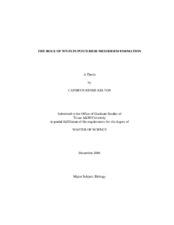| dc.description.abstract | The formation of vertebrate mesoderm relies on the integration of positional
information provided by several intercellular signaling pathways, including the Wnt and
Bone Morphogenic Protein (Bmp) pathways. Zygotic Wnt signaling has been shown in
multiple vertebrate systems to perform two functions: to restrict the size of the dorsal
mesoderm structure known as the organizer, and to promote the development of
posterior mesoderm that populates the trunk and tail. Importantly, the organizer is a
source of secreted Bmp antagonists that regulate Bmp-dependent ventral and posterior
mesoderm patterning. Because the organizer impacts Bmp signaling activity, it is not
clear whether functions attributed to zygotic Wnt signaling are in fact indirectly due to
reduced Bmp activity.
The objective of this thesis is to test the hypothesis that zygotic Wnt signaling
plays two critical functions: to restrict the size of the organizer and to promote posterior
mesoderm development in a Bmp-independent manner. To test this hypothesis, we
characterized in depth the phenotypic defects of zebrafish embryos lacking Wnt8, the
central ligand involved in zygotic Wnt-dependent mesoderm patterning. To identify
Bmp-independent functions of Wnt8 signaling, we used double loss-of-function conditions to elevate Bmp signaling in embryos lacking Wnt8 function. Embryos were
analyzed for the expression of a comprehensive set of mesoderm markers indicative of
cell fates found in all spatial positions of the embryo.
Our results show that, in addition to posterior mesoderm precursors being
drastically reduced in Wnt8 morphants, anterior fates are disrupted as well. We found
that increasing Bmp signaling largely has no effect on the Wnt8 morphant phenotype.
However, slight rescue was observed in pronephric, heart tube, and vasculature
precursors. We believe these results support the hypothesis that Wnt signaling maintains
mesoderm progenitor cell populations, while Bmp signaling patterns mesoderm cell
fates. Accordingly, Wnt8 signaling will appear to be epistatic to Bmp signaling during
vertebrate axis patterning. | en |


